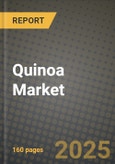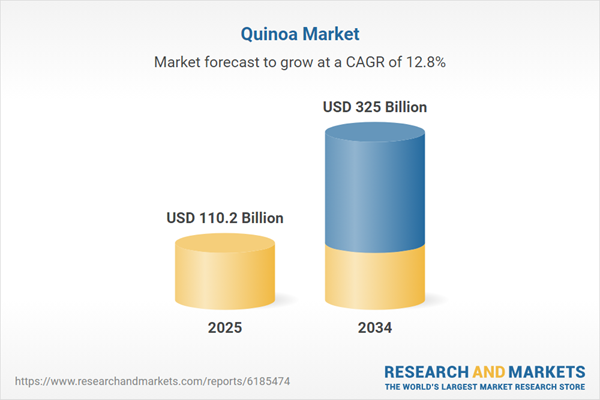Market Overview
The quinoa market has experienced significant growth in recent years, driven by the increasing demand for plant-based, gluten-free, and high-protein food options. Native to the Andean region of South America, quinoa has gained global recognition due to its nutritional profile, offering a complete source of protein, essential amino acids, and fiber. It is widely regarded as a superfood, making it a popular choice among health-conscious consumers, vegans, and those with dietary restrictions. Quinoa is used in a variety of food products, including salads, breakfast cereals, snacks, and flour, and is also utilized in the production of plant-based meat alternatives. As consumer preferences shift towards healthier, sustainable eating habits, the demand for quinoa has risen steadily, especially in Western markets. Additionally, quinoa is seen as a more sustainable crop compared to other grains, as it requires less water and is more adaptable to diverse climatic conditions. However, the quinoa market faces challenges related to production limitations, price volatility, and competition from other plant-based protein sources. While it remains a niche product in many regions, quinoa’s appeal continues to grow as part of a broader trend towards healthier and more sustainable food choices.The quinoa market continued to expand, fueled by increased consumer awareness of its health benefits and the growing popularity of plant-based diets. Quinoa production in key exporting countries like Bolivia, Peru, and Ecuador saw steady growth, although challenges related to climate change and land degradation impacted overall yields. To address these challenges, some farmers and organizations have focused on implementing sustainable farming practices and improving agricultural techniques to increase crop resilience. Meanwhile, global demand for quinoa remained strong, especially in North America and Europe, where it became a staple in many health-focused food products. Additionally, quinoa’s role as an alternative to traditional grains like rice and wheat has continued to gain traction in both the retail and foodservice sectors. Product innovation in the quinoa market has also been significant, with new products such as quinoa-based snacks, protein powders, and ready-to-eat meals entering the market to cater to the increasing demand for convenience and health-oriented options. Despite these positive developments, the market still faces challenges related to price volatility and supply chain disruptions, which can affect the availability and affordability of quinoa for consumers.
The quinoa market is expected to experience continued growth, driven by increasing global demand for plant-based and functional foods. As more consumers adopt plant-based and gluten-free diets, quinoa is likely to become an even more prominent ingredient in a wide range of food products, from snacks to beverages and meat alternatives. In addition, quinoa’s versatility as a sustainable and nutrient-dense crop makes it an attractive option for both small-scale and industrial food producers. As technology and innovation in agricultural practices continue to evolve, quinoa production is expected to become more efficient, with advancements in crop genetics and farming techniques helping to improve yield and quality. The development of new quinoa-based products, such as ready-to-cook meals and meal kits, will likely boost consumer adoption, especially in regions where convenience is a key driver. Furthermore, as more countries seek to diversify their food sources and strengthen their food security, quinoa is expected to see an expansion in cultivation outside of its native regions, including in countries with suitable climates. However, price fluctuations and concerns around the sustainability of large-scale quinoa production may continue to pose challenges to the market's long-term growth.
Key Insights: Quinoa Market
- Increased demand for quinoa as a high-protein, gluten-free alternative to traditional grains, particularly among health-conscious consumers and those following plant-based diets.
- Growth of quinoa-based products in the convenience food sector, such as ready-to-eat meals, snacks, and protein bars, catering to the increasing preference for on-the-go, nutritious options.
- Expansion of quinoa cultivation beyond its traditional Andean regions, with new farming initiatives in countries like the United States, Canada, and parts of Africa and Asia to meet growing global demand.
- Ongoing innovations in quinoa-based food products, including quinoa flour, quinoa protein powder, and quinoa-based beverages, expanding the versatility of quinoa in the food and beverage industry.
- Increased focus on sustainable farming practices, such as organic quinoa production, to mitigate the environmental impact of quinoa farming and ensure long-term supply chain stability.
- Rising consumer preference for plant-based, gluten-free, and nutrient-dense food options, fueling the demand for quinoa as a healthy and versatile ingredient in various food products.
- Growing popularity of quinoa in Western markets, particularly in North America and Europe, where it is increasingly incorporated into health-focused diets and functional food products.
- Increased awareness of quinoa’s sustainability benefits, with its lower water usage and adaptability to diverse climates compared to other grains, making it an attractive choice for eco-conscious consumers.
- Innovations in quinoa-based food products, such as ready-to-cook meals, snacks, and protein powders, providing more options for consumers seeking convenient, health-oriented solutions.
- Price volatility and supply chain disruptions, often caused by factors such as climate change, farming conditions, and fluctuating global demand, continue to pose challenges to the affordability and availability of quinoa in the market.
Quinoa Market Segmentation
By Type
- Organic
- Inorganic
By Application
- Food Industry
- Cosmetic Industry
- Pharmaceutical Industry
- Other Applications
By End User
- Ingredient
- Packed Food
Key Companies Analysed
- Sharp Corporation
- General Mills Inc.
- Ardent Mills LLC
- The Hain Celestial Group
- Quinoa International Corp
- Grain Millers Inc.
- Morning Foods Ltd.
- The British Quinoa Company
- Hancock Seed Company
- Andean Valley SA
- Alter Eco Americas Inc.
- Quinoa Corporation
- Heritage Harvest Seed
- Andean Naturals Inc.
- Victory Seed Company
- Blue Lake Milling Pty Ltd.
- Inca Organics
- Quinoa Foods Company
- Irupana Andean Organic Food S.A.
- Territorial Seed Company
- Northern Quinoa Production Corporation
- Keen One Foods LLC
- Adaptive Seeds
- Agrophilia
- ComRural S.R.L.
- Quinoabol S.R.L.
- Inca Health Organic SAC
- Mewar Impex
- European Quinoa Group
- The Real Seed Collection Ltd.
Quinoa Market Analytics
The report employs rigorous tools, including Porter’s Five Forces, value chain mapping, and scenario-based modeling, to assess supply-demand dynamics. Cross-sector influences from parent, derived, and substitute markets are evaluated to identify risks and opportunities. Trade and pricing analytics provide an up-to-date view of international flows, including leading exporters, importers, and regional price trends.Macroeconomic indicators, policy frameworks such as carbon pricing and energy security strategies, and evolving consumer behavior are considered in forecasting scenarios. Recent deal flows, partnerships, and technology innovations are incorporated to assess their impact on future market performance.
Quinoa Market Competitive Intelligence
The competitive landscape is mapped through proprietary frameworks, profiling leading companies with details on business models, product portfolios, financial performance, and strategic initiatives. Key developments such as mergers & acquisitions, technology collaborations, investment inflows, and regional expansions are analyzed for their competitive impact. The report also identifies emerging players and innovative startups contributing to market disruption.Regional insights highlight the most promising investment destinations, regulatory landscapes, and evolving partnerships across energy and industrial corridors.
Countries Covered
- North America - Quinoa market data and outlook to 2034
- United States
- Canada
- Mexico
- Europe - Quinoa market data and outlook to 2034
- Germany
- United Kingdom
- France
- Italy
- Spain
- BeNeLux
- Russia
- Sweden
- Asia-Pacific - Quinoa market data and outlook to 2034
- China
- Japan
- India
- South Korea
- Australia
- Indonesia
- Malaysia
- Vietnam
- Middle East and Africa - Quinoa market data and outlook to 2034
- Saudi Arabia
- South Africa
- Iran
- UAE
- Egypt
- South and Central America - Quinoa market data and outlook to 2034
- Brazil
- Argentina
- Chile
- Peru
Research Methodology
This study combines primary inputs from industry experts across the Quinoa value chain with secondary data from associations, government publications, trade databases, and company disclosures. Proprietary modeling techniques, including data triangulation, statistical correlation, and scenario planning, are applied to deliver reliable market sizing and forecasting.Key Questions Addressed
- What is the current and forecast market size of the Quinoa industry at global, regional, and country levels?
- Which types, applications, and technologies present the highest growth potential?
- How are supply chains adapting to geopolitical and economic shocks?
- What role do policy frameworks, trade flows, and sustainability targets play in shaping demand?
- Who are the leading players, and how are their strategies evolving in the face of global uncertainty?
- Which regional “hotspots” and customer segments will outpace the market, and what go-to-market and partnership models best support entry and expansion?
- Where are the most investable opportunities - across technology roadmaps, sustainability-linked innovation, and M&A - and what is the best segment to invest over the next 3-5 years?
Your Key Takeaways from the Quinoa Market Report
- Global Quinoa market size and growth projections (CAGR), 2024-2034
- Impact of Russia-Ukraine, Israel-Palestine, and Hamas conflicts on Quinoa trade, costs, and supply chains
- Quinoa market size, share, and outlook across 5 regions and 27 countries, 2023-2034
- Quinoa market size, CAGR, and market share of key products, applications, and end-user verticals, 2023-2034
- Short- and long-term Quinoa market trends, drivers, restraints, and opportunities
- Porter’s Five Forces analysis, technological developments, and Quinoa supply chain analysis
- Quinoa trade analysis, Quinoa market price analysis, and Quinoa supply/demand dynamics
- Profiles of 5 leading companies - overview, key strategies, financials, and products
- Latest Quinoa market news and developments
Additional Support
With the purchase of this report, you will receive:- An updated PDF report and an MS Excel data workbook containing all market tables and figures for easy analysis.
- 7-day post-sale analyst support for clarifications and in-scope supplementary data, ensuring the deliverable aligns precisely with your requirements.
- Complimentary report update to incorporate the latest available data and the impact of recent market developments.
This product will be delivered within 1-3 business days.
Table of Contents
Companies Mentioned
- Sharp Corporation
- General Mills Inc.
- Ardent Mills LLC
- The Hain Celestial Group
- Quinoa International Corp
- Grain Millers Inc.
- Morning Foods Ltd.
- The British Quinoa Company
- Hancock Seed Company
- Andean Valley SA
- Alter Eco Americas Inc.
- Quinoa Corporation
- Heritage Harvest Seed
- Andean Naturals Inc.
- Victory Seed Company
- Blue Lake Milling Pty Ltd.
- Inca Organics
- Quinoa Foods Company
- Irupana Andean Organic Food S.A.
- Territorial Seed Company
- Northern Quinoa Production Corporation
- Keen One Foods LLC
- Adaptive Seeds
- Agrophilia
- ComRural S.R.L.
- Quinoabol S.R.L.
- Inca Health Organic SAC
- Mewar Impex
- European Quinoa Group
- The Real Seed Collection Ltd.
Table Information
| Report Attribute | Details |
|---|---|
| No. of Pages | 160 |
| Published | October 2025 |
| Forecast Period | 2025 - 2034 |
| Estimated Market Value ( USD | $ 110.2 Billion |
| Forecasted Market Value ( USD | $ 325 Billion |
| Compound Annual Growth Rate | 12.7% |
| Regions Covered | Global |
| No. of Companies Mentioned | 30 |








